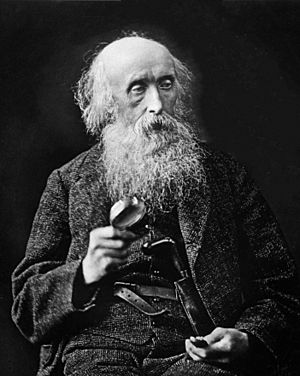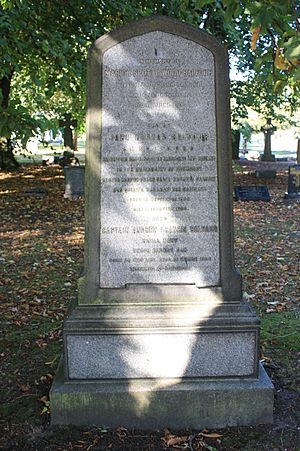John Hutton Balfour facts for kids
Quick facts for kids
John Hutton Balfour
|
|
|---|---|

Balfour in 1878
|
|
| Born | 15 September 1808 Edinburgh, Scotland, UK
|
| Died | 11 February 1884 (aged 75) Inverleith House, Edinburgh, Scotland, UK
|
| Nationality | British |
| Alma mater | Royal High School, University of St Andrews and University of Edinburgh |
| Spouse(s) | Marion Spottiswood Bayley |
| Children | 8; including Isaac Bayley Balfour |
| Awards | FRSE FRS FRCSE FLS MWS |
| Scientific career | |
| Fields | botany |
| Institutions | Royal Botanic Garden Edinburgh, Botanical Society of Edinburgh, Oxford University |

John Hutton Balfour (born September 15, 1808 – died February 11, 1884) was an important Scottish botanist. A botanist is a scientist who studies plants. He became a Professor of Botany at the University of Glasgow in 1841. Later, in 1845, he moved to the University of Edinburgh. He also became the 7th person in charge of the Royal Botanic Garden Edinburgh and the official Botanist to the Queen. He kept these jobs until he retired in 1879. People sometimes called him "Woody Fibre" because of his love for plants.
Contents
John Hutton Balfour: A Life in Plants
Early Life and Education
John Hutton Balfour was born in Edinburgh, Scotland. His father, Andrew Balfour, was an Army Surgeon. After his army service, his father started a printing and publishing business in Edinburgh.
John went to the Royal High School in Edinburgh. Then he studied at St Andrews University and the University of Edinburgh. He earned degrees in both Arts (M.A.) and Medicine (M.D.) in 1832. While at Edinburgh, he was an active member of the Plinian Society. Here, he met William A.F. Browne, who studied how the brain affects personality. John joined many lively discussions about nature and religion.
At first, John wanted to become a minister in the Church of Scotland. But he changed his mind. After studying abroad, he started working as a doctor in Edinburgh in 1834. In January 1835, when he was just 26, he became a member of the Royal Society of Edinburgh. He was one of their longest-serving members. He also served as their General Secretary and Vice President.
Becoming a Botanist
John Hutton Balfour loved botany. He helped start two important groups: the Botanical Society of Edinburgh in 1836 and the Edinburgh Botanical Club in 1838. He was even the President of the Botanical Society in 1845–46.
In 1841, he started teaching botany classes in Edinburgh. His classes were very popular. In 1842, he became a Professor of Botany at the University of Glasgow. Then, in 1845, he moved back to Edinburgh. He took over the botany department at the University of Edinburgh. He also became the keeper of the Royal Botanic Garden and the Queen's Botanist.
Teaching and Research
Balfour was a very successful teacher of botany. He often added religious ideas to his science lessons. He believed that studying nature could help people understand God. He also talked with famous scientists like Charles Darwin about plants. He even corresponded with Hewett Cottrell Watson, another botanist who studied how plants grow in different areas.
Growing the Royal Botanic Garden
Under Balfour's leadership, the Royal Botanic Garden in Edinburgh grew and improved a lot. New buildings were added, including a special house for palm trees. An arboretum, which is a collection of trees, was also created. More classrooms were built for students to learn about plants.
He wrote many important books about botany. These include:
- Manual of Botany (1848)
- Class Book of Botany (1852)
- Outlines of Botany (1854)
- Elements of Botany for Schools (1869)
- Botanist's Companion (1860)
- Introduction to Palaeontological Botany (1872)
- The Plants of Scripture
He also wrote part of the botany article for the 8th edition of the Encyclopædia Britannica. John Hutton Balfour retired from his teaching job in 1879.
A Plant Named After Him
A type of pine tree found in California is named after him. It is called Pinus balfouriana Balf., or the foxtail pine. This shows how important his work was in the world of botany.
His Family and Legacy
John Hutton Balfour lived in Inverleith House from 1877. This house was inside the Royal Botanic Gardens in Edinburgh. He lived there because of his role as the Regius Keeper.
He passed away in Inverleith House in 1884. He was buried next to his wife, Marion Spottiswood Balfour, in Warriston Cemetery in Edinburgh.
John and Marion had eight children. One of their sons, Sir Isaac Bayley Balfour (1853–1922), also became a famous botanist. He followed in his father's footsteps. Isaac became a professor at Oxford University and later took over his father's old job at the University of Edinburgh.
John Hutton Balfour's sister, Magdalene Balfour, married William A. F. Browne. William was known for his studies of the brain and for helping improve mental hospitals. John Hutton Balfour was also the uncle of Sir Andrew Balfour, who was a specialist in tropical medicine. Sir Andrew helped start the London School of Hygiene & Tropical Medicine.
Interestingly, the famous actress Tilda Swinton is a great-great-granddaughter of John Hutton Balfour.

